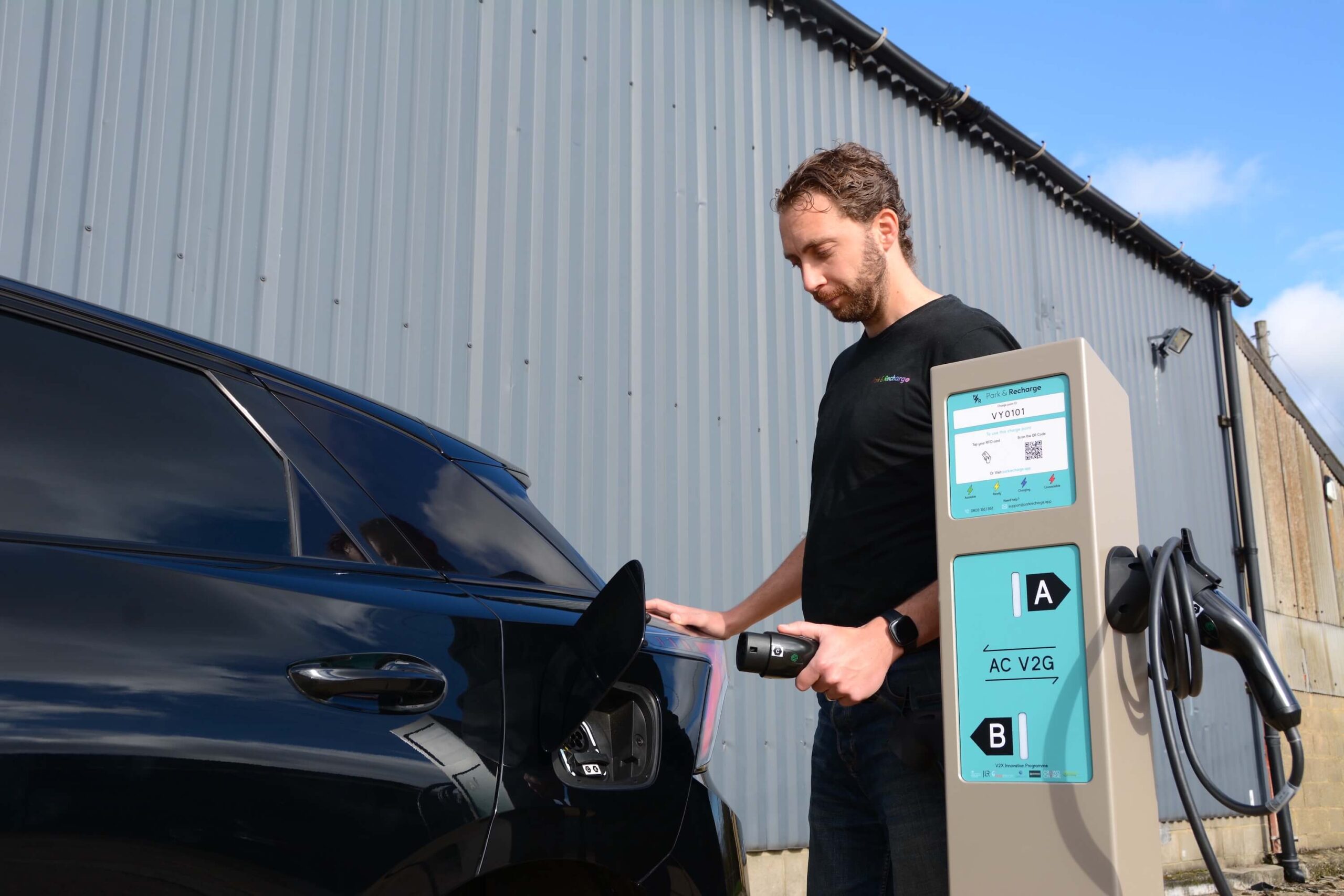Vehicle to Grid EV Charging Trial
The V2VNY Vehicle to Grid EV Charging Trial is aiming to help accelerate mainstream adoption of V2G technology in order to reduce emissions and save money.
The project
The V2VNY Vehicle to Grid EV Charging Trial aims to demonstrate, test and refine new, next-generation vehicle to grid (V2G) electric vehicle (EV) workplace charging technology which offers the opportunity to lower carbon emissions and reduce energy costs, paving the way for its broader adoption.
The project offers businesses the opportunity to trial bidirectional workplace charging with certain electric vehicles on their fleet which feature ‘vehicle to load’ technology. The primary aim of the project is to determine the performance of the V2G charging technology in a commercial context across a number of use cases, including fleet, staff charging and home-to-work scenarios.
V2G technology enables EVs to be charged at times when electricity costs are low, and then put energy back into the grid, or into a building or even another EV, when electricity costs are higher.
Blazing a trail
This is one of the first V2G trials in the UK to use AC (alternating current) charging with the latest generation of EVs featuring ‘vehicle to load’ technology; most previous V2G trials used Nissan EVs with CHAdeMO DC (direct current) charging technology. Trial participants need at least two electric vehicles on their fleet which feature vehicle to load technology from the brands of Genesis, Hyundai, Kia or MG.
Businesses are provided with a free 7kW AC bidirectional charger with two sockets and a software package to optimise the charging. Participants can keep the charger after the trial but will have to pay for the installation of the charger and for continued use of the software after the end of the trial.
The V2VNY trial commenced in September 2024 and runs through to the end of March 2025.
To take part in the V2VNY project, businesses need to have at least two of the following electric cars on their fleet:
- Genesis GV60
- Hyundai IONIQ 5
- Hyundai IONIQ 6
- Hyundai Kona (2023 onwards)
- Kia EV6
- Kia EV9
- Kia Niro EV (2023 onwards)
- MG 4
- MG 5
- MG ZS (2021 onwards)

Background
The numbers of electric vehicles are increasing. Charging these rising numbers of EVs will have an impact on local electricity networks, however smart charging can help to move demand away from peak times.
But vehicle to grid charging offers a lot more than just smart charging: it allows the ability for potentially millions of EVs to smart charge using renewable energy and act as battery storage facilities, and then send energy in a vehicle’s battery to the grid, to buildings, or to other vehicles, and to trade energy.
Using the resource of over one million large capacity battery packs in the UK that sit idle most of the time – a number which is set to grow significantly over the coming years – can help reduce the load on electricity networks at peak times. This means that rather than EVs being seen as a problem in relation to grid capacity, they can be an important solution to help balance the grid.
However V2G hasn’t yet been trialled sufficiently with the latest EVs on Britain’s electricity networks to enable it to be rolled out on a country-wide basis – hence the need for this trial.
The project will look at how this battery capacity can be used to improve how, where, and when energy is used, with the aim of reducing carbon emissions and saving energy costs – to benefit businesses, electricity operators and the country as a whole.
Our partners
The V2VNY Vehicle to Grid EV Charging Trial is being led by Hangar 19, in partnership with CrowdCharge and DriveElectric. Other project partners are GridBeyond, Oxfordshire County Council, Electric Corby and JLR. JLR is providing prototype electric vehicles for use in the trial.







Funding
The ‘Vehicle 2 Volume eNergy Yield’ (V2VNY) Phase 2 project, part of the V2X Innovation Programme, is funded by the Department for Energy Security and Net Zero (DESNZ), delivered by Innovate UK. The V2X Innovation Programme is part of the up to £65m Flexibility Innovation Programme, funded from the £1 billion Net Zero Innovation Portfolio.
The V2VNY Phase 1 feasibility study and development project proved the viability of bidirectional AC charging with a range of vehicle types including Hyundai, Kia and MG.

FAQ
What is Vehicle to grid (V2G)?
Vehicle to grid (V2G) is charging for an electric vehicle that is bi-directional, i.e. power can be supplied from the grid to charge the EV, and it can also go from the EV back to the grid – or to a building or to another vehicle.
The technology to send energy from an EV to the grid, buildings or vehicles is known as ‘vehicle to everything’ (V2X). The full list of V2X-related three-letter acronyms are:
- V2L = vehicle to load
- V2H = vehicle to home
- V2B = vehicle to building
- V2G = vehicle to grid
- V2I = vehicle to infrastructure
- V2V = vehicle to vehicle.
What are the benefits of V2G?
V2G allows an EV to be charged when electricity costs and the associated carbon emissions are low. It then allows electricity to be sent back to the grid, for example at times of peak demand – when an EV owner could get paid for providing this service.
Therefore V2G can potentially help an EV owner gain an income, as well as help the grid operator balance grid capacity.
Can my EV work with V2G?
V2G has traditionally worked with EVs with CHAdeMO charging technology, which featured on the Nissan LEAF. CHAdeMO is DC, or high-power technology, which needs a DC charger, which is expensive; there are no ‘mass-market’ DC V2G chargers.
Virtually all of the latest EVs now use CCS technology rather than CHAdeMO. Historically CCS hasn’t worked with V2G, however the industry standards to enable this to happen are due to be implemented by 2025.
Manufacturers say that a number of EVs currently work with V2G in principle, but this doesn’t always appear to be the case in practice. The V2VNY project is using EVs from Genesis, Hyundai, Kia or MG with (AC) ‘vehicle to load’ technology, ie. using the car’s Type 2 charging socket, which has been proven to work with an AC V2G charger.
Does V2G need a special charger and if so, how much will that cost?
V2G requires a V2G charger. Such chargers aren’t generally commercially available; some DC chargers do exist but are expensive, but there are virtually no AC V2G chargers in existence, aside from the ones on this project – hence its groundbreaking nature! AC V2G chargers, when commercially available, will be more affordable than DC V2G chargers.
Does the UK electricity industry have a mechanism to support V2G?
V2G needs an EV, a charger, and the ability make it all work through an energy supplier. The energy industry is currently developing business models for V2G; one energy supplier has announced that it is introducing the UK’s first vehicle to grid tariff.
Project News
AC/DC?: New Groundbreaking Vehicle to Grid EV Charging Trial Uses Lower Cost Technology
The V2VNY project explores the effectiveness of reducing carbon emissions and energy costs by using an AC (alternating current) V2G ev charger.
Next steps
Find out how CrowdCharge AI can supercharge your products and services and benefit your customers.
We will not share your details with any third party.
